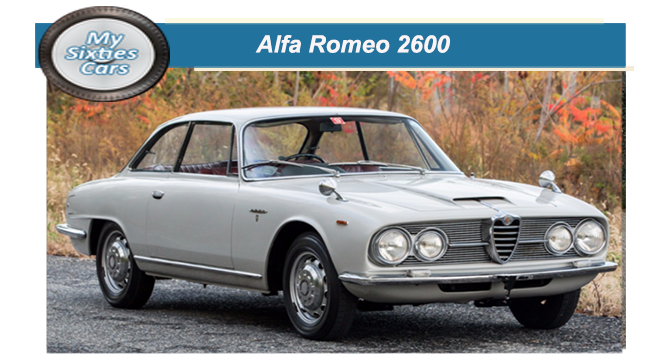
The 2600 range was launched in 1961 as Alfa Romeo´s flagship going into the Sixties.
In what had now become a proven Alfa Romeo format, the 2600 range comprised a salon, coupe and Spider Softop.
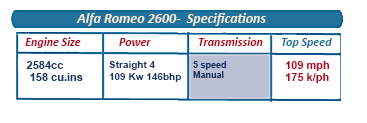 The 2600 was earmarked to be the successor to the Alfa Romeo 2000; the 2600 carried some considerable historical significance as the last model to have been fitted with an inline six-cylinder engine with twin overhead camshafts, the traditional Alfa Romeo engine configuration since the Nineteen Twenties
The 2600 was earmarked to be the successor to the Alfa Romeo 2000; the 2600 carried some considerable historical significance as the last model to have been fitted with an inline six-cylinder engine with twin overhead camshafts, the traditional Alfa Romeo engine configuration since the Nineteen Twenties
By the Fifties, the cumbersome to handle, expensive but very powerful six cylinders gradually gave way to four-cylinder engines as the factory oriented its production towards more economical models that were geared more towards mass-production.
TheAlfa Romeo 2600 first saw the light of day at the Geneva Motor Show of 1962.
T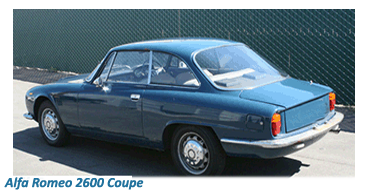 he Berlina 2600 sedan was produced in its entirety by Alfa Romeo in-house, while the two-plus-two seater convertible (2600 Spider)and coupe versions 2600 Sprint) were produced for Alfa Romeo by Carrozzeria Touring, and Bertone respectively.
he Berlina 2600 sedan was produced in its entirety by Alfa Romeo in-house, while the two-plus-two seater convertible (2600 Spider)and coupe versions 2600 Sprint) were produced for Alfa Romeo by Carrozzeria Touring, and Bertone respectively.
Design for the 2600 was the work of the talented young designer Giorgetto Giugiaro - his first significant project in his new post of head designer for Carrozeria Bertone.
![]()
In the annals of the Italian car industry, Giugiaro designs for the Alfa Romeo 2600 laid the foundations for many of the models released by Alfa during the Sixties.
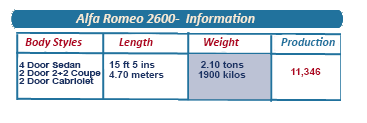 Regarded as being among the designs that most influenced automotive styling in Italy for decades to follow.
Regarded as being among the designs that most influenced automotive styling in Italy for decades to follow.
All of the three versions of the 2600 were loosely based on its predecessor, 2000 with the major updates between the two in the series’ powertrain, an entirely re-designed all-alloy 2.6-litre engine with six cylinders in line backed up by twin overhead camshafts.
To provide more power for the heavier Berlina saloon, twin carburettors were added, generating a total of 130 bhp.
T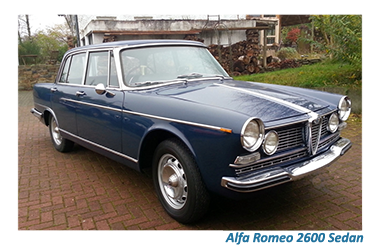 he engines that powered the lighter Sprint and Spider variations came fitted with three twin-choke horizontal carburettors capable of developing a formidable 145 bhp.
he engines that powered the lighter Sprint and Spider variations came fitted with three twin-choke horizontal carburettors capable of developing a formidable 145 bhp.
Despite the Alfa Romeo management’s high hopes, the 2600 series turned out to be a bit of a disappointment, both commercially and critically.
Among the downsides that the ever critical Italian motoring media hastened to point out was that while the three versions of 2600 looked good, their looks flattered to deceive as most of the mechanical parts used on the 2600 were carried over from the 2000 series.
![]()
These parts, designed in the mid-Fifties, meant that, apart from the new engine, the 2600 was far from a leader in cutting edge technology.
Despite its shortcomings, the 2600 range remained in production at the top of the Alfa range until 1968, when it was replaced by the Giorgetto Giugiaro designed 1750 series.
T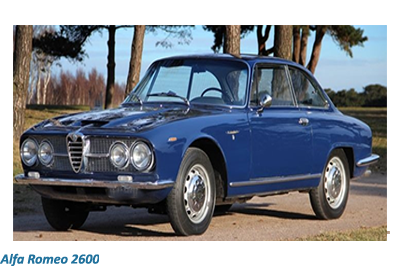 otal production for the 2600 series during its production run was 11,490 with, the Sprint Coupe topping the list at 6999, the Spider Softop way behind at 2255, the Berlina saloon 2038, the Sprint Zagato 105 and the 2600 Deluxe making up the numbers at just 54 cars.
otal production for the 2600 series during its production run was 11,490 with, the Sprint Coupe topping the list at 6999, the Spider Softop way behind at 2255, the Berlina saloon 2038, the Sprint Zagato 105 and the 2600 Deluxe making up the numbers at just 54 cars.
Today, as classics, the 2600 Sprint and Spider are appreciated for the tasteful and opulent styling of both the bodywork and the interior, for the performance, technology, and sound of the six-cylinder twin-cam engine, and perhaps ironically for their rarity compared to the more successful Alfa Romeo models of the same era.






